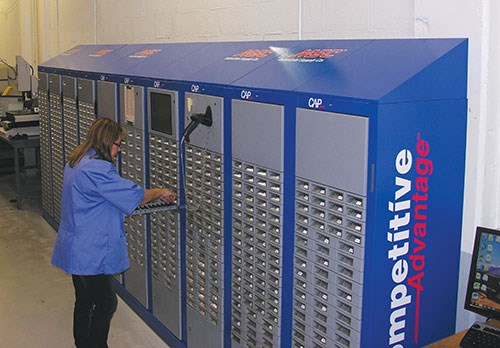Tool Vending Systems: Value Beyond Cost Control
Learn how can a tool vending system can also be a learning tool.
Share










Tool vending systems like this one can enable shopfloor supervisors to help operators find out why tools are breaking or wearing sooner than expected.
3D Medical Manufacturing, the medical job shop profiled in this article, is currently on its second iteration of a tool vending system: a system from MSC Industrial. This system enables the shop to accurately track every nondurable tool for each job while providing daily tool usage reports for those jobs. This enables tight cost control and ensures that the shop never runs out of the tools it needs, which was a problem in the past that led to extended machine downtime and high next-day shipping charges. The vending system automatically reorders tools once a specified minimum inventory level is reached, and the shop’s tool crib manager reloads the tools when they’re delivered.
However, this system also serves as an important problem-solving device. Each job has a maximum number of tools that an operator can pull. The system locks out operators who attempt to pull a tool beyond that limit and notifies a supervisor of the situation. That way, the supervisor can work with the operator to determine why tools are breaking or wearing sooner than expected. In some cases, the operator can precisely explain the problem, meaning a change to the process might be warranted. In other cases, the operator might be unsure of the problem. Therefore, the notification turns into a teachable moment, because the supervisor can help the operator pinpoint the issue and remedy it.
The shop also has expanded this concept to its inspection devices, some of which are supplied by customers. This eliminates time wasted looking for special gages, for example, and ensures accountability for those devices.
Related Content
-
Quick-Change Tool Heads Reduce Setup on Swiss-Type Turning Centers
This new quick-change tooling system enables shops to get more production from their Swiss turning centers through reduced tool setup time and matches the performance of a solid tool.
-
Custom PCD Tools Extend Shop’s Tool Life Upward of Ten Times
Adopting PCD tooling has extended FT Precision’s tool life from days to months — and the test drill is still going strong.
-
How to Mitigate Chatter to Boost Machining Rates
There are usually better solutions to chatter than just reducing the feed rate. Through vibration analysis, the chatter problem can be solved, enabling much higher metal removal rates, better quality and longer tool life.






























.png;maxWidth=300;quality=90)




.png;maxWidth=970;quality=90)